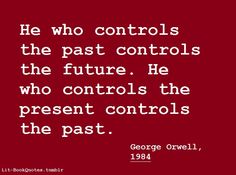I’ve discussed George Orwell’s book 1984 before in my blogs. Some years ago I was quite surprised when none of my college students had ever heard of the book. Back in my day, we all studied it in high school. It’s fascinating to watch how Orwell’s descriptions align with our modern society, especially lately.
Censorship of “crimethink” (see Orwell’s 1984) has become a big issue around the world. When I worked in China decades ago, it was difficult to access western web pages. My own company’s website had not been approved by the government so I couldn’t access it for needed files. That was a little understandable back when the Internet was new, but what’s it like today?
Last year when I lived in China, I got used to controlling my speech because there were lots of topics we could never discuss in public or even private conversations, and certainly not on the Internet. The Internet was highly censored; news items that contradicted official government positions were banned, as were individuals who were deemed a threat to society for voicing opinions or reporting news. In some cases, such people became unpersons.
If you haven’t looked at China Daily, you should, because that’s what the American news media resembles. There is news, conveyed with attractive images and video. But already, only one point of view and only approved speech is permitted, and the scope of approved speech is narrowing. Other opinions, as well as inconvenient facts, are deemed crimethink and censored and banned.
More broadly, the cancel culture prevents “crimethink” on college campuses and doxes people for crimethink to impact their employment.
Some thoughts from Twitter accounts that haven’t been banned yet:
Either the government will regulate technology or technology will regulate the government.
This was the year the Fake News became so powerful they could tell you there was definitely no election fraud because you aren’t allowed to check. And it worked.
_____
Regarding censorship generally, here’s a relevant tweet from Brian Roemmele (assuming Twitter doesn’t ban him before you read this).
https://twitter.com/BrianRoemmele/status/1347702746850361345
The thing about studying history and the decline of cultures is all “team” are fully convinced that if they just could better control what people, thought, felt, read and talked about “society would be better”. It has never worked. It will never work. We have amnesia.
_____
In LDS culture, some of our most prominent apologists have long engaged in ad hominem attacks (attacking the person instead of the argument), which is the equivalent of doxing for crimethink. I plan to release a book about LDS apologists later this year, which I’m sure many will find quite interesting. One of my favorites is an anonymous blogger endorsed by one of the best-known LDS apologists.
People have asked me to focus on the critics such as MormonStories and CES Letter instead of the faithful scholars in the citation cartel. It’s a valid point. But how effective is it to point out the evidence and rational arguments that support what Joseph and Oliver taught, when both the critics and the LDS apologists agree that Joseph and Oliver were wrong?
In my view, both groups are effective for similar reasons: they both elevate their own theories and interpretations over the plain words of the prophets.
Some LDS apologists seem to think it’s a good idea to repudiate what Joseph and Oliver taught, as if doing so would ingratiate themselves with the critics. I disagree with that approach. I respect both the critics and the LDS scholars, all of whom are undoubtedly well-intentioned from their various perspectives, but I don’t agree with their theories and interpretations. You can see my responses to MormonStories here. https://mormonstoriesreviewed.blogspot.com/
_____
We might think that after spending $28 million, the citation cartel would have some effective responses to the critics, but instead, their editorial policy of censorship of other faithful LDS has led to (i) agreement with the critics on key points and (ii) more confusion among members of the Church.
One of the reasons why I object to the ongoing censorship by Book of Mormon Central and the rest of the citation cartel is that censorship is a short-sighted error. It makes no sense to me for the cartel to insist that the only allowed theories are the ones that portray Joseph Smith and Oliver Cowdery as ignorant speculators who misled the Church about the New York Cumorah and the translation of the plates with the Urim and Thummim, but that’s what our scholars are doing.
The Church History Department continues to de-correlate both of those elements of Church history, solely to accommodate the theories of a handful of scholars in the M2C citation cartel.
Seriously, when your very logo announces to the world that you reject what Joseph and Oliver taught, and you censor alternative interpretations of historical evidence that is faithful to Joseph and Oliver, what outcome do you expect?
Look especially at the Mayan glyph (which doesn’t belong with the other scriptural languages anyway, but is purely an insistence on M2C). The figure has a line down the side of its face that represents closing off the mind. It’s an image of the closed-mindedness editorial policy of Book of Mormon Central and the rest of the citation cartel that justifies censorship.
You might find it unbelievable that this logo depicting a closed mind attaches itself to so much LDS apologetics. But it’s not actually unbelievable. Instead, it’s consistent and descriptive.
Source: About Central America

